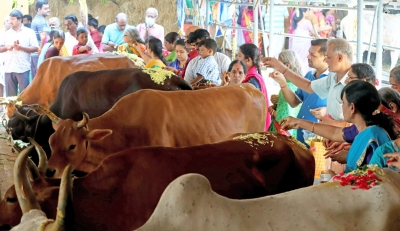GST revamp to boost cooperative sector, 10 crore dairy farmers: Govt
By IANS | Updated: September 6, 2025 15:30 IST2025-09-06T15:28:06+5:302025-09-06T15:30:09+5:30
New Delhi, Sep 6 The landmark Goods and Services Tax (GST) reforms will strengthen the cooperative sector, make ...

GST revamp to boost cooperative sector, 10 crore dairy farmers: Govt
New Delhi, Sep 6 The landmark Goods and Services Tax (GST) reforms will strengthen the cooperative sector, make their products competitive, boost demand or their products and enhance income of cooperatives, the government said on Saturday.
The Centre has announced wide-ranging reductions in GST across key sectors that directly impact cooperatives, farmers, rural enterprises and benefit more than 10 crore dairy farmers in the country.
These reforms will promote rural entrepreneurship, promote cooperatives in food processing sector and ensure affordable access to essential goods for millions of households.
According to the Ministry of Cooperation, GST rate reductions will benefit cooperatives in farming and animal husbandry, promote sustainable farming practices, and benefit small farmers and FPOs.
In the dairy sector, direct relief has been provided to farmers and consumers as milk and paneer, whether branded or unbranded, have been exempted from GST, while the tax on butter, ghee and similar products has been reduced from 12 per cent to 5 per cent, and GST on milk cans made of iron, steel or aluminium has also been lowered from 12 per cent to 5 per cent.
These measures will make dairy products more competitive, provide direct relief to dairy farmers, and strengthen women-led rural enterprises, particularly self-help groups engaged in milk processing.
In food processing and household items, a major relief has been given as GST on cheese, namkeens, butter and pasta have been reduced from 12 per cent or 18 per cent to 5 per cent, while jams, jellies, yeasts, bhujia and fruit pulp or juice-based drinks are now taxed at 5 per cent.
Chocolates, corn flakes, ice creams, pastries, cakes, biscuits and coffee have also seen a reduction from 18 per cent to 5 per cent.
Lower GST will reduce household expenditure on food items, stimulate demand in semi-urban and rural areas, and promote growth in the food processing and dairy cooperative sectors. It will further boost food processing, milk processing cooperatives and private dairies, raising farmer incomes.
Additionally, GST on packing paper, cases, and crates has been reduced to 5 per cent, easing logistics and packaging costs for cooperatives and food producers.
The GST on tractors below 1,800 cc has been reduced to 5 per cent, which will make tractors more affordable and benefit not only crop farmers but also those engaged in animal husbandry and mixed farming, as these tractors can be used for fodder cultivation, transporting feed, and managing farm produce more efficiently, while tractor components such as tyres and tubes, hydraulic pumps, and several other parts have also seen a reduction from 18 per cent to 5 per cent, further lowering costs and directly benefiting many cooperatives in the farming sector.
The GST on key fertiliser inputs such as ammonia, sulphuric acid and nitric acid has been reduced from 18 per cent to 5 per cent, correcting the inverted duty structure, lowering input costs for fertiliser companies, preventing price hikes for farmers, and ensuring timely availability of affordable fertilisers during sowing seasons, which will directly benefit many cooperatives in the farming sector.
Similarly, the GST on 12 bio-pesticides and several micronutrients has been reduced from 12 per cent to 5 per cent, promoting eco-friendly and sustainable farming practices by making bio-based inputs more affordable, encouraging farmers to shift from chemical to bio-pesticides for better soil health and crop quality, giving direct benefits to small organic farmers and FPOs in alignment with the Government’s Natural Farming Mission.
The change will again benefit many cooperatives in the farming sector.
The GST on commercial goods vehicles such as trucks and delivery vans has been reduced from 28 per cent to 18 per cent, lowering the upfront capital cost of trucks which form the backbone of India’s supply chain by carrying nearly 65–70 per cent of goods traffic, thereby reducing freight rates per tonne-km and creating a cascading effect that makes the movement of agricultural goods cheaper, cuts logistics costs, and improves export competitiveness.
Disclaimer: This post has been auto-published from an agency feed without any modifications to the text and has not been reviewed by an editor
Open in app